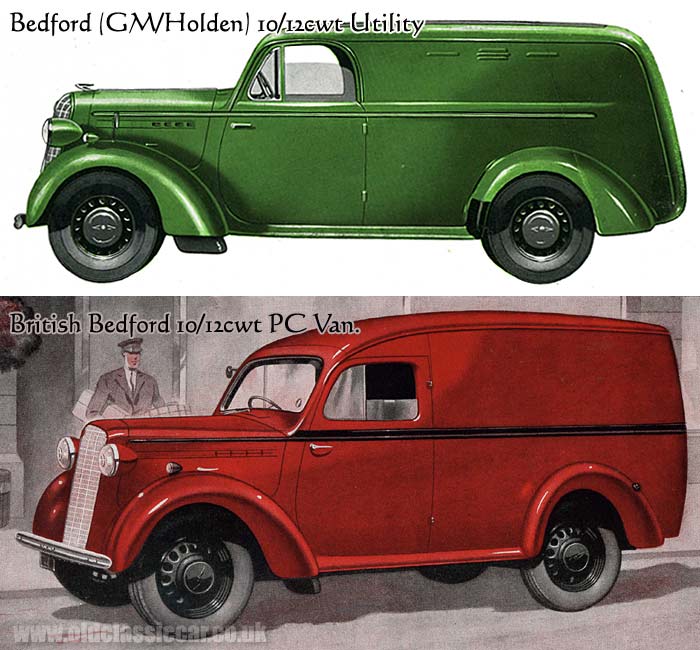Bedford/GMH station wagon.
Alan sent these photographs over from his home in Australia. They show a van-based Bedford station wagon that belonged to his late father, and he wondered whether it was a factory production model or not.
|
The vehicle is based on the British Bedford PC 10/12cwt van range. Kits comprising the chassis, running gear and front end panelwork were shipped out to Australia, where they'd be assembled by the General Motors (Holden), or GMH, concern. Imported vehicles had to incorporate a certain percentage of local - ie Australian - content in them, hence the part-complete vehicles that the British arm of GM exported to Australia. The vehicles were then bodied by Holden in one of several forms. A technical specifications leaflet issued by General Motors Holden's Limited in December 1948 lists the following variants and related body codes:
- Chassis with sedan type cowl (PC 6100)
- Coupe Open Utility (PC 6106)
- Coupe Wellside Utility (PC 6108)
- Panel Van (PC 6104)
There is no mention in this spec sheet, or in any of the factory brochures I have of an estate car, or station wagon, version of the panel van. Therefore my guess is that this is a conversion effected by a third-party coachbuilder, based on a standard GMH Panel Van. If anyone can identify the coachbuilder responsible for this conversion, please drop me a line. Or was this simply a one-off built by a talented individual in their back yard? Alan also sent over photos of a pre-war Morris Commercial van, owned by his father while they lived in the UK.
|
| (Please click the thumbnail to view full-size image.) |
|
|
|
|
The GM Holden / Bedford panel van.
Note the rear passenger door incorporated within the wagon's nearside rear bodywork, and the addition of side windows. The two images shown below, which Alan received from a Vauxhall/Bedford enthusiast in his country, both show the standard Holden-bodied panel van. The van featured two side-hinged doors to the rear, whereas the station wagon shown in Alan's photos has a split-level arrangement.
|

|
|
Alan adds:
|
|
"Some family photos of a Bedford "Station Wagon" that my late father owned in Sydney, N.S.W. I hope that you find them interesting, & can you please tell me if this vehicle was a standard production model, or a "home made" one? It had a "Bedford" badge on it, not a "Holden" one, & was maroon coloured. It had a column gearshift as far as I remember.
|
|
The back bench seat had a back that folded forward, resulting in a flat area behind the front seat to the rear doors, so that large items could be carried there.
|
|
I was told by my late father that it was built in
1949, & I know that he bought two Vauxhall Wyvern workshop manuals, (one
thick one, & one thin one), so he could do some repairs on it at various
times. He bought them when a motor mechanic told him that the
engine, transmission etc., i.e.all but the bodywork, were the same as that in
the Vauxhall Wyvern sedan of that era. I agree with you that it was more of
an estate car than a van, & the bodywork appeared to be factory made to me,
even though the only back side door was on the left hand side.
|
|
I remember that General Motors Holden in the 1950s built or assembled
Vauxhalls, & possibly Bedfords, so I will contact Holden & ask them if
they have an archives section that may have details of this vehicle. I will
let you know what they tell me. I don't ever remember seeing another one of
these vehicles, so apparently very few of them were built.
|
|
I read on a website, (possibly yours), that English-built Bedfords had a
single windscreen, while Holden-built ones had two windscreens that were
divided by a central verticle support bar. This was because of the many
gravel roads in Australia causing lots of broken windscreens when stones
were thrown through the air by the types of oncoming vehicles. It was
cheaper to replace a generally flat smaller piece of glass than one big,
possibly curved piece."
|
|
Update. Alan has been back in touch again. While sorting through another collection of old family photos, he turned up this side view of the Bedford PC estate / wagon taken in mid-1958. The location was the (then) 2-lane Mona Vale Rd., Terrey Hills, in the northern outskirts of Sydney. The similarity with the Holden-bodied van shown further up the page is clear, as is the lack of a rear side door on the offside of the car. Thanks Alan!
|
|
|
Comparing the British and Australian panel vans.
After buying three ute versions of the Bedford PC in '06 I tracked down a number of brochures for the Australian-built version of the British Bedford PC range. Shown below is a scan showing the Australian-bodied panel van, with an additional scan of a British PC van for comparison. The one-piece screen on the British van is clear to see, as are the very different cab doors and rear bodies.
|

|
|
Buyers in the UK could opt for a Utilavan version of the PC, an estate-car conversion made to the van by outside coachbuilder Martin Walter Ltd.
|
|
Return to Page 12 in the vintage and classic car gallery.
|
|
A period shot of a Bedford ute, again Holden-bodied, can be found on this page in this gallery section, whereas elsewhere on the site are photos of various surviving PC utes, including the three I found.
|







